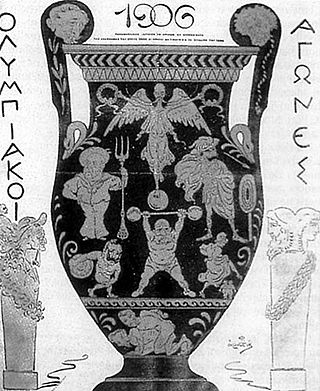
Pistol dueling was a sport at the 1906 Intercalated Games and 1908 Olympics.

Pistol dueling was a sport at the 1906 Intercalated Games and 1908 Olympics.
In the 1906 Intercalated Games, competitors fired duelling pistols at plaster dummies from distances of 20 m (22 yd) and 30 m (33 yd). [1]
In 1908, pistol dueling was demonstrated as part of the concurrent Franco-British Exhibition, using the Olympic fencing arena and in front of invited guests. [2] There were no official demonstration sports until 1912. The competition involved two competitors firing at each other with dueling pistols loaded with wax bullets and wearing protective equipment for the torso, face, and hands. [1] [3] Teams were sent by countries including France, the UK, and the USA. The 20-meter competition was won by the French team of Major Ferrus, J Marais and J Rouvcanachi. [2]
| Event | Gold | Silver | Bronze |
|---|---|---|---|
| 20 m duelling pistol | |||
| 30 m duelling pistol |

Shooting sports is a group of competitive and recreational sporting activities involving proficiency tests of accuracy, precision and speed in shooting — the art of using ranged weapons, mainly small arms and bows/crossbows.

The 1906 Intercalated Games or 1906 Olympic Games, held from 22 April 1906 to 2 May 1906, was an international multi-sport event that was celebrated in Athens, Greece. They were at the time considered to be Olympic Games and were referred to as the "Second International Olympic Games in Athens" by the International Olympic Committee (IOC). However, the medals that were distributed to the participants during these games were later not officially recognised by the IOC and are not displayed with the collection of Olympic medals at the Olympic Museum in Lausanne, Switzerland.

The 1908 Summer Olympics were an international multi-sport event held in London, England, from 27 April to 31 October 1908. The 1908 Games were originally scheduled to be held in Rome, but were relocated on financial grounds following the violent eruption of Mount Vesuvius in 1906, which claimed over 100 lives; Rome eventually hosted the Games in 1960.

A duelling pistol is a type of pistol that was manufactured in matching pairs to be used in a duel, when duels were customary. Duelling pistols are often single-shot flintlock or percussion black-powder pistols which fire a lead ball. Not all fine, antique pairs of pistols are duelling pistols, though they may be called so.
Alexandros Theofilakis was a Greek shooter.

Shooting sports have been included at every Summer Olympic Games since the birth of the modern Olympic movement at the 1896 Summer Olympics except at the 1904 and 1928 games.

The 25 metre muzzle-loading pistol was one of the five sport shooting events on the 1896 Summer Olympics shooting programme. The armament of the American Paine brothers was disqualified because of not being "of the usual calibre" for the event. With the Paine brothers declining the offer of the Greek shooters to use their pistols, only four shooters entered the fourth shooting event. Three nations were represented. Each shooter fired five strings of six shots at a target 25 m (27 yd) distant. The competition was held on 11 April and resulted in the top two places going to the Greek marksmen. Nielsen took third place and Merlin did not finish.

Cecil Patrick Healy was an Australian freestyle swimmer of the 1900s and 1910s, who won silver in the 100 m freestyle at the 1912 Summer Olympics in Stockholm. He also won gold in the 4 × 200 m freestyle relay. He was killed in the First World War at the Somme during an attack on a German trench. Healy was the second swimmer behind Frederick Lane to represent Australia in Swimming and has been allocated the number "2" by Swimming Australia on a list of all Australians who have represented Australia at an Open International Level.

Léon Ernest Moreaux was a French sports shooter and Olympian who competed in pistol and rifle shooting in the late 19th century and early 20th century.

George Valentine Bonhag was an American athlete and a member of the Irish American Athletic Club and the New York City Police Department. He competed in distance events, both racewalking and running, at the 1904, 1908 and 1912 Olympics and at the 1906 Intercalated Games.

The men's 30 metre dueling pistol was a shooting sports pistol event held as part of the 1912 Summer Olympics shooting programme. It was later standardized by the ISSF to the men's 25 metre rapid fire pistol. It was the third appearance of the event, as it had not been featured at the 1908 Games. The competition was held on Saturday, 29 June 1912. Forty-two sport shooters from ten nations competed. Nations were limited to 12 shooters each. The event was won by Alfred Lane of the United States, in the nation's debut. Sweden, also making its debut, earned the silver and bronze medals.

Johan Verner Weckman was a wrestler who was the first Finnish Olympic gold medalist.

The men's ISSF 25 meter rapid fire pistol was a shooting sports event held as part of the Shooting at the 1924 Summer Olympics programme. It was the fifth appearance of the event. The competition was held on 28 June 1924 at the shooting ranges at Versailles. 55 shooters from 17 nations competed. Nations were limited to four shooters each. Henry Bailey won the United States' second consecutive championship in the event. Sweden also earned the same medal as in 1912, with Vilhelm Carlberg's silver. Lennart Hannelius took bronze in Finland's debut in the event.

Gustaf Eric Carlberg was a Swedish Army officer, diplomat, sport shooter, fencer, and modern pentathlete who competed at the 1906, 1908, 1912 and 1924 Olympics alongside his twin brother Vilhelm.

Raoul Marie Joseph Count de Boigne was a French sport shooter who competed at the 1906 Intercalated Games, the 1908 Summer Olympics and 1912 Summer Olympics. He was born in Geneva, Switzerland and died in Ouveillan, France.
Frangiskos Mavrommatis was a Greek sport shooter who competed at the 1906 Intercalated Games, the 1908 Summer Olympics and the 1912 Summer Olympics.
Pierre Edmond Payssé was a French gymnast and teacher. He won two gold medals at the 1906 Intercalated Games in Athens, Greece, and later worked to increase participation in women's sports.
Sofia Marinou was a Greek tennis player, who won two silver medals at the 1906 Intercalated Games in Athens, Greece.
Pistol dueling was a competitive sport developed around 1900 which involved opponents shooting at each other using dueling pistols adapted to fire wax bullets. The sport was briefly popular among some members of the metropolitan upper classes in the US, UK and France. Although the bullets were made of soft wax they could inflict significant damage to exposed flesh. For this reason the competitors wore heavy protective clothing and guards. The sport was demonstrated at the 1908 Olympic Games but did not survive the First World War. It may be seen as a precursor of the modern sport of paintball.